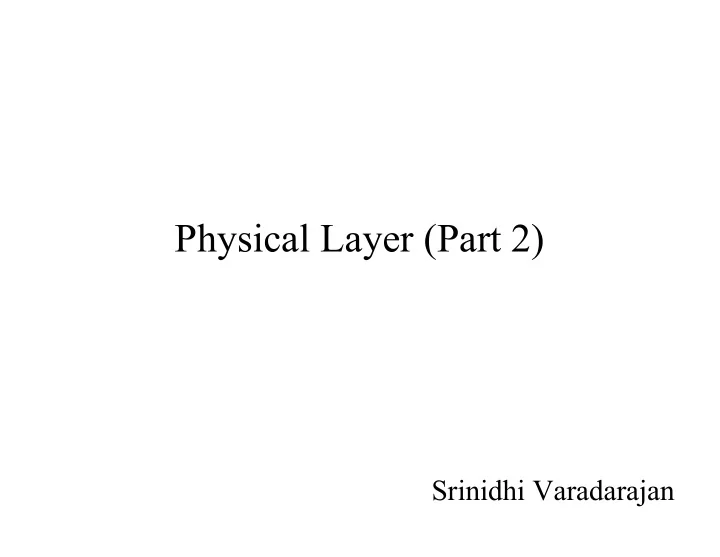

Physical Layer (Part 2) Srinidhi Varadarajan
Fourier Series • Even and Odd functions: – Even functions mirror around the Y-axis (cos θ ) – Odd functions invert around the Y axis (sin θ ) • A Fourier series expresses a time-domain function as a series of harmonics of sines and cosines. – The basic Fourier series expresses are periodic function. – Aperiodic functions are involve a continuum of frequencies – leads to the Fourier transform • Why is it useful? – Hint: Tells you something about the frequency
Fourier Series ∞ ∞ A = + π + π ( ) 0 sin( 2 ) cos( 2 ) g t A nft B nft ∑ ∑ n n 2 = = 1 1 n n T 2 = ( ) A g t dt ∫ 0 T 0 T 2 = π ( ) sin( 2 ) A g t nft dt ∫ n T 0 T 2 = π ( ) cos( 2 ) B g t nft dt ∫ n T 0 Take a look at : – http://sunlightd.virtualave.net/Fourier/
Nyquist’s Sampling Theorem • The bit and the baud – Using multiple signaling levels. Baud * log 2 (signaling levels) = bits/sec • If a signal is passed through an arbitrary low pass filter of bandwidth B, it can be reconstructed by a sampler collecting 2B samples/sec – Reasoning: Frequency components higher than the sampling rate are already filtered out. • Max data rate = 2B log 2 V bits/sec, – Where V is the number of discrete levels in the signal.
Thermal Noise: Shannon’s Theorem • Nyquist theorem is used for noiseless channels. – Real world communication channels are noisy. At the minimum, you have thermal noise • Signal to Noise ration S/N is expressed in dB as 1 0log 1 0 (S/N). – Recall the -3db cutoff point. • Shannon’s Theorem: – Max data rate = B log 2 ( 1 +S/N) – This is an upper bound independent of the number of signaling levels and sampling rate.
Point-to-Point Protocols and Links ( 1 ) • Point-to-point protocols involve exactly two peer entities or modules that are connected by some “link” • The modules must interact to ensure the proper transfer of information using the link “Link” Module at Module at Node A Node B
Point-to-Point Protocols and Links (2) • For example, the link may be: – Physical link (e.g. RS-232 is a point-to-point protocol) – Virtual bit pipe (e.g. at the data link layer) – A connection or virtual connection (e.g. at the transport or session layer)
Data Link Control -- DLC ( 1 ) • For each point-to-point link in a network there are two data link control (DLC) peer modules, one at each end • DLC modules use a distributed algorithm to transfer packets – Received from and delivered the network layer • Usual objective is to deliver packets in order of arrival (from the network layer) without errors or repeated packets
Data Link Control -- DLC (2) • DLC modules must use the unreliable “virtual bit pipe” provided by the physical layer Network Network DLC DLC Physical Physical
Data Link Control -- DLC (3) • DLC must: – Detect errors (using redundancy bits) – Request retransmission if data is lost (using automatic repeat request -- ARQ) – Perform framing (detect packet start and end) – Support initialization and disconnection operations
Data Link Control -- DLC (4) • These functions require that extra bits be added to the packet to be transmitted – Header bits are added to the front of each each packet – Trailer bits are added to the rear of each packet – The header, packet from upper layer (service data unit), and trailer form a frame header service data unit trailer frame
Frame Format • The packet from the upper layer is the service data unit (SDU) • The frame (header, network layer packet, and trailer) is the protocol data unit (PDU) • Note that the DLC does not care what is in the network layer packet and the physical layer does not care what is in the frame generated by the data link layer header service data unit trailer frame
Recommend
More recommend